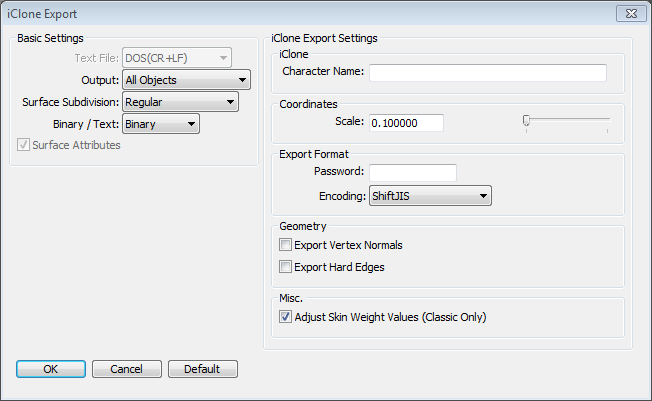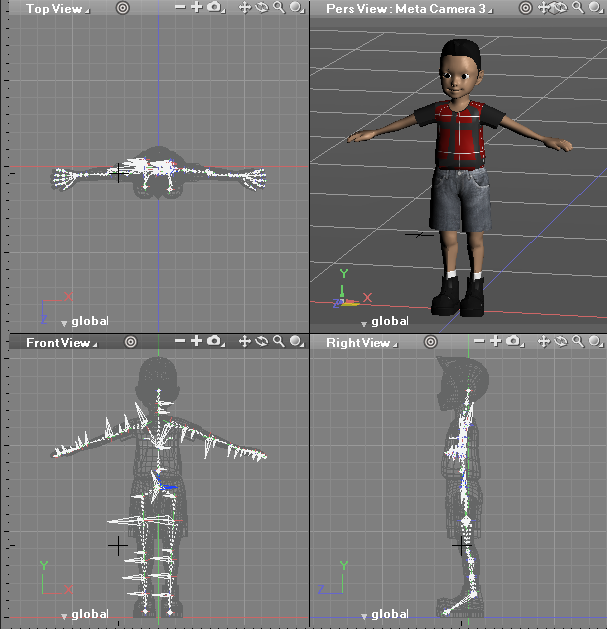iClone Export (Windows Only)
iClone Export is a plugin which exports models created with Shade3D as iClone (*.iAvatar) files. Exported objects appear on the Custom tab of the iClone's Character content manager.
iClone Export is only available in the Windows version of Shade3D. To use iClone Export, your computer must have either iClone 5 or higher or 3DXchange 4 or higher installed.
iClone Export Dialog Box

Select File > Export > iClone... to open the iClone Export dialog box.
The file type, encoding, coordinates scale and other settings can all be specified for the exported file.
Note Because iClone Export exports data optimized for iClone, the settings in the iClone Export dialog box are already automatically optimized; some options may not be able to be changed.
- iClone Export Settings Group
-
- Character Name Text Box
- Specifies the name of the figure as it will appear in the exported model.
- Coordinate Options Group
-
- Scale Text Box and Slider
- Specifies the size ratio when exporting a figure.
- Export Format Group
-
- Password Text Box
- Enter a password here to password-protect the iClone file (optional).
- Encoding Pop-up Menu
- Select either UTF-8 or ShiftJIS for the text encoding used for object names in the exported iClone file.
Note Password protection is only available when Binary is selected from the Type pop-up menu.
- Geometry Group
-
- Export Vertex Normals Checkbox (13.1)
- Exports the vertex normal of each face. Exporting the normals results in larger file sizes, so deselect this option unless necessary.
- Export Hard Edges Checkbox (13.1)
- If a single vertex is shared by multiple faces and each normal has a different orientation, adds new vertices at the same positions and separates these from the shared vertex.
This is useful when smooth shading is not desirable for face borders in the case of tools that do not accept normals.
- Misc. Options Group
-
- Adjust Skin Weight Values Checkbox
- Specifies the handling of Skin Window joint settings during export.
If selected, skin values are automatically converted and adjusted. If deselected, skin values are exported as-is. Normally it is better to select this option.
iClone Exporter Specifications
Exported Objects
Objects are exported as either singular or multiple meshes.
| Shade3D Objects | iClone | Notes |
|---|---|---|
| Closed line | All exported as a single mesh, or exported as multiple meshes. | When closed line objects in Shade3D are not part of the same flat surface, they are divided into triangles. The Hole checkbox in the Object Info Window is not currently supported. |
| Revolved line | The Closed checkbox and Begin and End parameters in the Object Info Window are supported for revolved line objects. | |
| Extruded line | ||
| Disk | ||
| Revolved disk | The Closed checkbox and Begin and End parameters in the Object Info Window are supported for revolved disk objects. | |
| Extruded disk | ||
| Sphere | ||
| Curved surface | ||
| Polygon mesh | Rounded corners of polygon meshes are supported. | |
| Meta mesh | ||
| Linked object |
Surface Materials Support
- Only image maps are exported.
- Multiple mapping layers are supported (Diffuse, Bump).
- Multiple UV layers are supported.
- Face Groups are supported.
- For projection mapping, only the Wrap option is supported.
- When applying Trim to material image mapping, adjust the Diffuse value of the image so that it is less than 1.0. If the Diffuse value is equal to 1.0, trimming will not be supported in the exported iClone file.
-
It is possible to use Alpha Transparency from the Surface window and apply the alpha image value to diffuse image mapping (13.2).
It requires a single layer of diffuse image to achieve the Transparency or Trim effects.
To use this type of Alpha Transparency, the selected diffuse image should contain alpha values such as those supported by the PNG or Targa image format.
Joints Support
-
Shade3D Objects iClone Notes Slider joint Part Scale joint Uni-scale joint Path joint Rotator joint Skeleton (13.1) Ball joint Skeleton Bone joint (13.1) Skeleton
Cameras Support
The Meta camera and other cameras are supported.
Lights Support
Object lights (point lights, spot lights, directional lights) as well as distant lights are supported.
Area lights and linear lights are not currently supported. Distant lights are exported as directional lights with a remote origin.
Using Template Files
- Use the template file included with Shade3D Standard and Professional located at Object/00_New/Professional_and_Standard_only/boy_iclone_template.shd for setting up iClone characters with bones.
- Create the character using polygon meshes, posed with its arms held up to the sides, forming a T shape.

- Place the center of the character's feet so they touch the ground at the origin.
- Delete the Skin settings from the polygon mesh of the character in the template file and replace with the character you wish to use.
The hierarchy under the Human Bone part can be used as-is for the character's bones. Do not change the bone names or hierarchy.
Without changing the bone Rotation elements or Scale, in Object Mode align the bones to each of the character's joints. - Once the position of the character and bones have been finalized, apply binding to the Skin and rotate the bones in Joint Mode to check the skin's deformation. If the skin deforms correctly, export to iClone with the iClone Exporter.
Important Notes Regarding iClone Export
- Only non-standard iClone characters can be exported.
- iClone does not support polygon meshes with more than 30,000 faces. You can lower the level of subdivision to reduce the number of faces.
- If subdivision surfaces are applied to polygon mesh objects, the joint values in the Skin Window may not be replicated correctly.
-
If the polygon face is too large, iClone may produces incorrect shading output due to further triangulation by iClone automatically.
In such case, subdivide the polygons into smaller triangles before the export. Otherwise, skin transformations may have unexpected results.